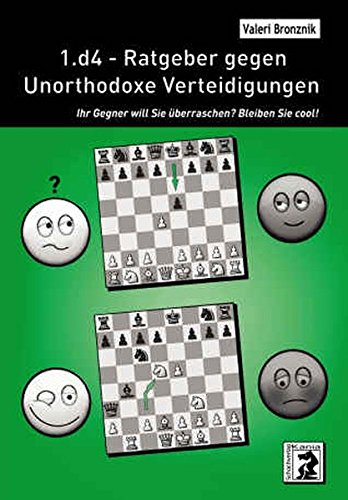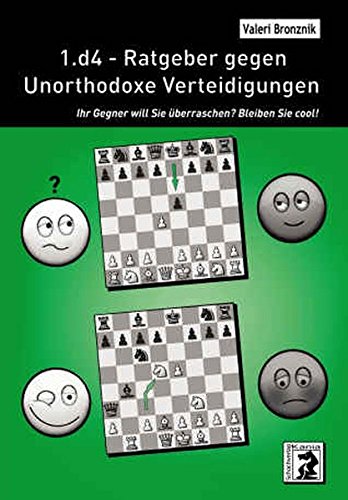Posts Tagged ‘Budapest Gambit’
1.d4 – Ratgeber gegen Unorthodoxe Verteidigungen
1.d4 – Ratgeber gegen Unorthodoxe Verteidigungen
By Valeri Bronznik
Schachverlag Kania, 2010
ISBN: 39783931192372
Much food for thought.
This excellent opening book looks at various unorthodox lines arising after 1.d4 and recommends a particular response to each one. In most cases circumspect response is the order of the day, not an overtly aggressive one.
Naturally, the book will be of greatest practical value to players who open with 1.d4 as white: these are its main, intended readership. Still, those who play the odd offbeat line against 1.d4 (or would like to investigate a few, at any roads) like the Polish (1…b5), the Albin (1…d5 2.c4 e5) or the Black Knights’ Tango (1…Nf6 2.c4 Nc6) will find the book to be interesting and suggestive, a useful source of ideas. What Valeri Bronznik provides is a serious, sober examination of opening systems that some other analysts have dismissed as dubious or downright bad, whereas many (though not all, in my humble opinion!) have merit. Often, you’ll end up with positions where both sides have problems to solve – even though White is allegedly ‘better’.
The material is set out in three parts and 19 chapters. Part 1 (chapters 1-8) covers various first moves for Black other than 1…d5 or 1…Nf6. Among the lines looked at are the Polish, the Englund Gambit (1…e5) and the Dutch Benoni (1…c5 2.d5 f5), which Jonathan Levitt has elsewhere christened the Clarendon Court Defence; the German author prefers a more descriptive or literal moniker. As for Part 2 (chapters 9-14), there Bronznik examines a number of lines arising after the moves 1.d4 d5 2.c4 and you will find chapters devoted to the Albin, Marshall’s move 2…Nf6, the Schara-Hennig Gambit (2…e6 3.Nc3 c5 4.cxd5 cxd4) and various Stonewall setups (e.g. 2…e6 3.Nc3 c6 4.e3 Bd6, as Ivanchuk played against Carlsen in 2009). Not the Noteboom though, which is a pity: one would like to have learned Bronznik’s thoughts on this double-edged variation. In the final part, Part 3 (chapters 15-19), Bronznik provides coverage of some systems following on from 1.d4 Nf6 2.c4; systems such as the Black Knights’ Tango, the Budapest Gambit (1.d4 Nf6 2.c4 e5 3.dxe5 and now either the usual 3…Ng4 or Fajarowicz’s 3…Ne4: both moves are discussed) and the so-called Snake Benoni (slithering into view following 1.d4 Nf6 2.c4 c5 3.d5 e6 4.Nc3 exd5 5.cxd5 Bd6).
Several original analyses are presented throughout the book, 58 to be exact, and there are about that many complete games, their annotations laden with theoretical references and astute judgements. Above all, it is the spirit of serious enquiry that impresses one most about Valeri Bronznik’s book. There is much food for thought.
Just one slight fault, which I can’t help but mention: the apostrophe in the title of chapter 19 comes before rather than after the ‘s’ (i.e. in the book it is ‘Black Knight’s Tango’ rather than the correct ‘Black Knights’ Tango’). English grammar always has the last laugh, even when a book is written in German, as here.
1.d4 – Ratgeber gegen Unorthodoxe Verteidigungen

This is an excellent opening book by an experienced author.
Valeri Bronznik looks at various unorthodox lines that might be tried against 1.d4 and recommends a particular response to each one. A circumspect response is usually the order of the day, not an overtly aggressive one.
The book will be of great practical value to players who open with 1.d4 as White: they are its main, intended readership. Still, those who play the odd offbeat line against 1.d4, or would like to investigate a few: say the Polish (1…b5), the Albin (1…d5 2.c4 e5) or the Black Knights’ Tango (1…Nf6 2.c4 Nc6), will find the book to be interesting and suggestive as well, a useful source of ideas. Bronznik provides a sober examination of opening systems that some other analysts have dismissed as dubious or downright bad, whereas many (though not all, in my humble opinion!) have merit. Often, you end up with positions where both sides have problems to solve – even though White is allegedly ‘better’.
The material is set out in three parts and 19 chapters. Part 1 (chapters 1-8) covers various first moves for Black other than 1…d5 or 1…Nf6. Among the lines looked at are the Polish, the Englund Gambit (1…e5) and the Dutch Benoni (1…c5 2.d5 f5), which Jonathan Levitt has christened the Clarendon Court Defence; the German author prefers a more descriptive or literal moniker. As for Part 2 (chapters 9-14), there Bronznik examines a number of lines arising after the moves 1.d4 d5 2.c4 and you will find chapters devoted to the Albin, Marshall’s move 2…Nf6, the Schara-Hennig Gambit (2…e6 3.Nc3 c5 4.cxd5 cxd4) and various Stonewall setups (e.g. 2…e6 3.Nc3 c6 4.e3 Bd6, as Ivanchuk played against Carlsen in 2009). Not the Noteboom though, which is a pity: one would like to have learned Bronznik’s thoughts on this double-edged variation. In the final part, Part 3 (chapters 15-19), Bronznik provides coverage of some systems following on from 1.d4 Nf6 2.c4; systems such as the Black Knights’ Tango, the Budapest Gambit (1.d4 Nf6 2.c4 e5 3.dxe5 and now either the usual 3…Ng4 or Fajarowicz’s 3…Ne4; both moves are discussed) and the so-called Snake Benoni (e.g. 1.d4 Nf6 2.c4 c5 3.d5 e6 4.Nc3 exd5 5.cxd5 Bd6).
Several original analyses are presented throughout the book, 58 to be exact, and there are about that many complete games, their annotations laden with theoretical references and astute judgements. Above all, it is the spirit of serious enquiry that impresses one most about Valeri Bronznik’s book; there is much food for thought.
Just one slight fault, which I can’t help but mention: the apostrophe in the title of chapter 19 comes before rather than after the ‘s’ (i.e. it is ‘Black Knight’s Tango’ rather than the correct ‘Black Knights’ Tango’). English grammar always has the last laugh, even when a book is written in German, as here.
The publisher’s description of 1.d4 – Ratgeber gegen Unorthodoxe Verteidigungen can be read here. And a pdf extract from the book is here.
Book Details
1.d4 – Ratgeber gegen Unorthodoxe Verteidigungen
By Valeri Bronznik
Schachverlag Kania, 2010
ISBN: 39783931192372
